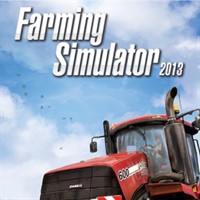Farming Simulator 2013: Cow husbandry
Basics
The last, the most expensive and the most demanding type of animals you can have on your farm are cows. After purchasing them, they're automatically transported to the pasture near field 35.

Cows produce three types of products: milk, manure and slurry. The first is sold automatically and you receive the money at the end of each day. The second and third are stored near the pasture and, similarly to a fertilizer, used to increase your harvest. Same as with sheep, if we want the cows to start producing milk and give manure, we first need to feed them. Unfortunately, they're quite picky, so if you keep feeding them the same type of fodder all the time, you won't be able to maximize their productivity, and as a result their milk will go for a much lower price. To prevent it, you're going to have to make a special mixed fodder yourself.
If you've only just begun breeding cows, you can easily feed them only one type of fodder. You can choose between hay, grass or silage. If you want to know how to get the two former ones, read the Cultivation - Straw and Grass section. Producing silage is a little bit more complicated. To do it, collect previously mowed grass with a forage wagon and transport it to a proper silo (they're located next to the biogas plant and the cow pasture).
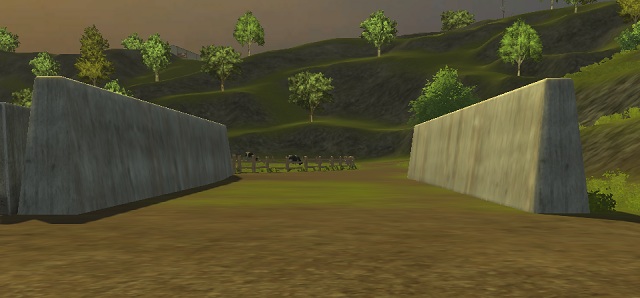
The silos can be also used to store chaff (corn, wheat, or even grass) made by using the Krone Big X 1000 combine - the result will be the same, though grass grows everywhere and is free, which makes it a much better material. You're going to have to do a couple of cruises, since you'll need to fill the silo on at least 10%. The next step is to compress the collected chaff to 100% (simply drive a tractor inside the silo) - as a result, you will get an option to ferment the whole material. Once you select it, the silo will be covered with a plastic sheet and you will only have to wait until the silage is ready.
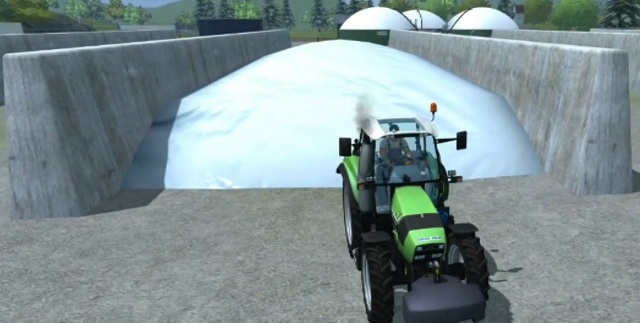
When you have the silage, you can transport it with a front loader equipped with special silo grips or silage forks (depending on the brand of the vehicle). If you had stored it near the cow pasture, just feed it to the cows by filling the manger. Given that silage production takes time and requires purchasing appropriate machinery, a beginning farmer who wishes to breed animals should stick to feeding them hay or grass only.
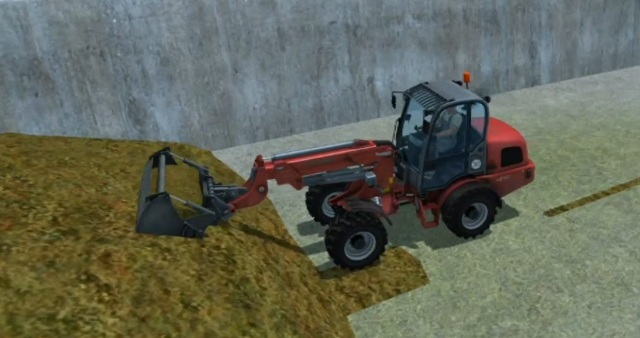
Once we have more money, we can start thinking about making our own fodder. To that end, buy one of the mixer wagons (Nutrition Engineering tab in the shop). The least expensive one is the Kuhn Profile 1880 - available for around 40000$. After buying it and attaching it to a tractor, a window displaying a percentage composition of the fodder inside will appear. Our job would be to adjust the proportions of each of component (hay, grass or silage) so that they're leveled between the two markers.
We can do it on a trial-and-error basis, or use a method already worked out by other players. Using a front loader, throw the following into the mixer wagon:
1x hay square
1x grass square
fill up with silage
Next, mount a tractor and turn the mixing on. Once you have homogeneous feed, put it in the manger. Add other feed types (grass, hay, silage) and after a few minutes wait the productivity of your cows should raise to 100% - and from now on you will be earning money from selling milk.
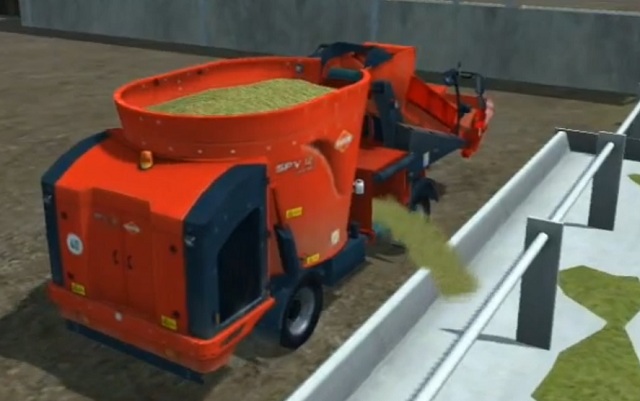
Minimum breeding option
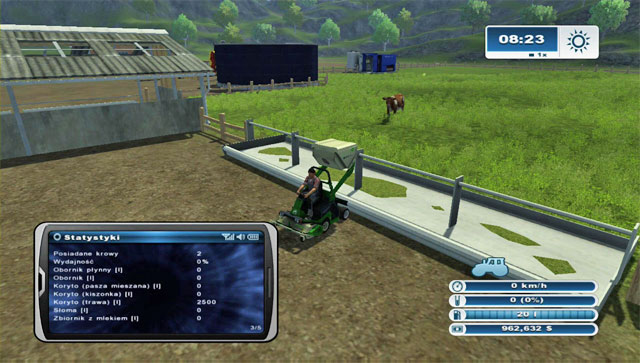
If you want to approach this harshly, you of course can. This option of breeding cows is however not very remunerative. Buy the basic AMAZONE Profihopper mower for 3 500 $ and drive towards the cow pasture. Mow the grass on your way and collect it into the small tank of the mower (2 500 l capacity). Afterwards unload it into the manger and buy 10 cows.
Each day, 10 cows will need around 1 500 l of grass. At the same time those cows will give you milk (with 35% efficiency) worth around 1300 $.
Investment: 35 500 $ (20 000 $ for 10 cows, 3 500 $ for the mower);
Return on investment: around 25-27 days (the daily profit might not be staggering, but the important fact is that cows don't require that much attention; when fed with grass only, the effectiveness is 35%);
Conclusion: husbandry at such a low scale isn't' very profitable, which doesn't mean that you shouldn't use it to diversify your farm and earn some money; the return on investment is rather long and profits aren't great either (remember about the daily cost of keeping a cow), but it might be a good activity for beginners, where brining mowed grass every 1-2 days and not having to worry about anything else is a quite good idea for a low, but constant income.
Optimum breeding option
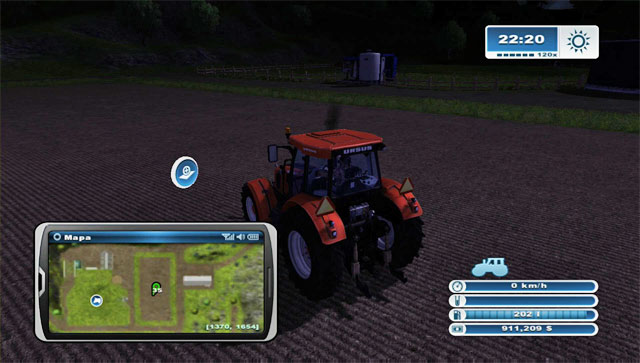
You however shouldn't stop there: buy field 35 for 22 000 $. Introducing a second type of food requires some more investments and work.
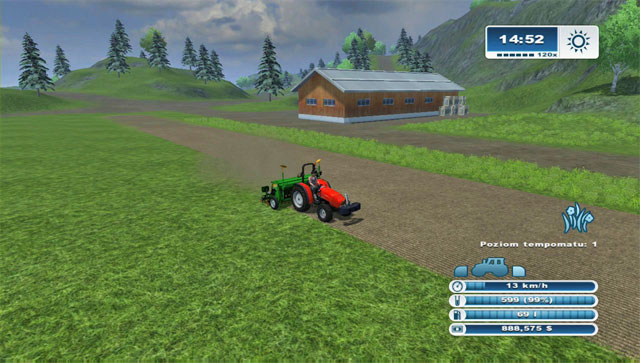
Bring a tractor and a sower to field 35 and plant grass. Keep in mind that you can take the sower away afterwards - mowed grass grows back after a while. In the future, if you will need more grass, you can consider buying the nearby field 30 or 41.

You will need grass, a lot of it in fact. In this option you will feed your cows with grass and silage. The ideal set for mowing grass is a medium tractor with a Kuhn PZ 280 F mower for 8 840 $ at the front and the Krone ZX 450 GD multi-purpose trailer for 99 820 $ at the back (don't buy the 10 000 $ cheaper Bergmann Shuttle 900 K as it cannot unload grass into a roofed manger).
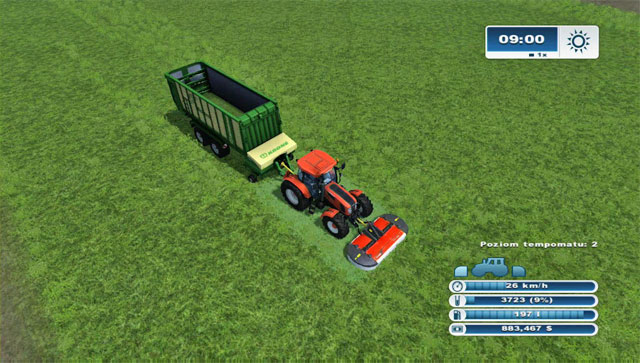
Head to the meadow: onto field 38 where you planted grass or to the nearby empty areas. Firstly turn on the trailer, switch to the mower, lower it and turn it on. Mow grass that way and you will simultaneously collect it onto the trailer (speed 2). Remember to buy more cows - considering the scale of the investment, 20 cows should be sufficient.
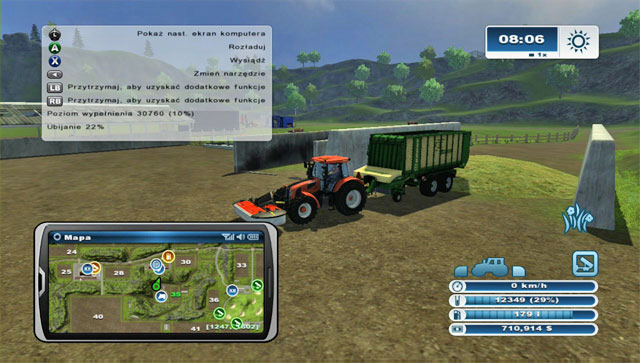
Mow around 30 000 l of grass and unload it into a special silo (west of the cow pasture). As field 35 won't supply you with enough grass, drive around the area to mow enough of it. You could buy field 30 for 49 100 $ and plant grass there, but it's another big expenditure. You can also wait for the grass to grow back on field 35.
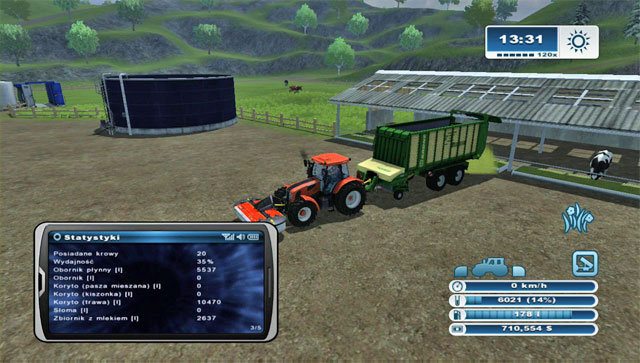
Unload the grass and drive the tractor over it to smash it - it will only take a moment. Afterwards, standing by the silo, press the corresponding button to close the silo and start creating silage. You will have to wait a bit for the fermentation process to proceed. In the mean time you can mow some more grass and unload it into the manger.
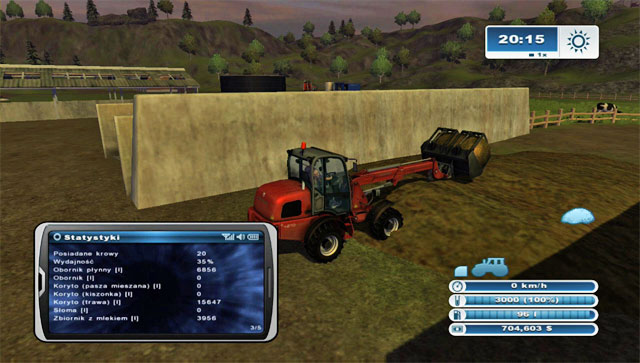
With the fermentation process complete, you will get exactly the same amount of silage as you put in grass. You need to use the lifter equipped with a silage fork. The cheapest one is the Weidemann 4270 CX100 T for 26 000 $ together with a fork for 2 500 $. Steering it might be problematic and rather unresponsive at first, but try to get a hang of it and load the first fork - it has a 3000 l capacity.
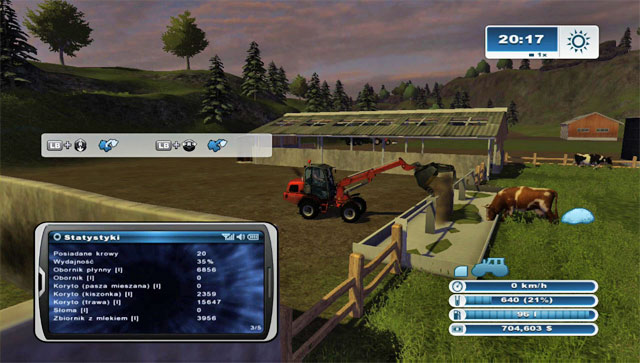
Drive a bit further to the manger and unload the whole fork. Once again it might be rather problematic, you have to first lift the fork, open it and only afterwards lower it. Ten courses and 30 000 l of silage will be available for your cows. Each day, 20 cows will need around 3 000 l of grass and over 2 200 l of silage. The profitability goes up with each cow that you buy:
Investment: 199 160 $ (40 000 $ for twenty cows, 22 000 $ for the field, 8 840 $ for the mower, 99 820 $ for the multi-purpose trailer, 28 500 $ for the loader; the sower isn't included as you're sure to have one);
Return on investment: around 27-28 days (daily income from milk from 20 cows fed with grass and silage is around 7 000 $; when fed with grass and silage 70%; assuming, that you bought the loader and mower previously for other activities, the initial cost falls to around 160 000 $ and the return on investment shortens to 23 days;
Conclusion: husbandry at such a scale in profitable, but it's still worth to expand it; at first you will have to devote much time to mow grass and produce silage, but afterwards you just have to refill the manger with those two and ferment new silage less often; the profitability increases with the number of cows and the return on investment shortens: if you buy 40 cows instead of 20, the initial investment will cost you around 240 000 $, the cows will eat around 6 000 l of grass around 4 500 l of silage per day, the daily profit from milk will be over 14 000 $ and the return on investment will be around 17 days.
Full scale cow husbandry
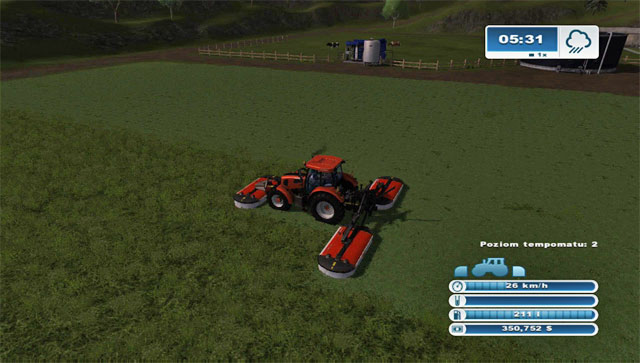
It's the most demanding activity in the game, thanks to which you can make some serious money. You don't use grass and silage to feed cows here, but you still need to produce them to mix into forage, so all previously mentioned expenditures still stand. At this stage you will change the way you feed your cows. In order to increase profitability, you should also buy more of them - a total of 50 cows for 100 000 $. Start off by mowing the grass. You can do it like until now, using the Kuhn PZ 280 F for 8 840 $ mounted at the front (in the future, when your cow husbandry develops further, you can also buy an additional Kuhn PZ 960 mower for 28 300 $ and mount it at the back to shorten the time considerably.
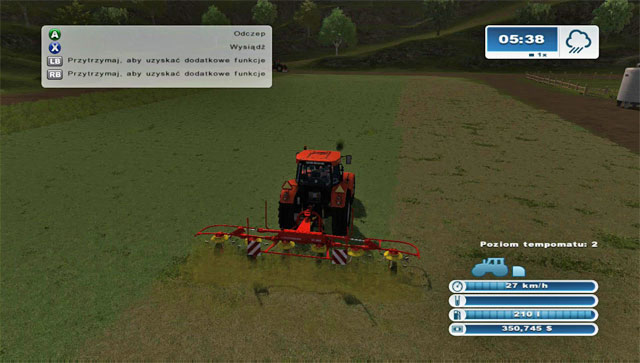
Afterwards use the tedder to turn over the grass so that it dries into hay (the cheapest Pottinger Eurohit 690 N will cost you 15 990 $).
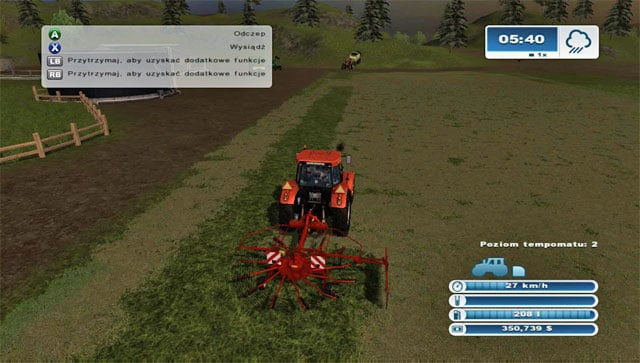
In order to make collecting hay easier, buy yourself a windrower - the cheapest Kuhn GA 4521 GM costs 8 200 $. In the future you should consider buying a wider one.
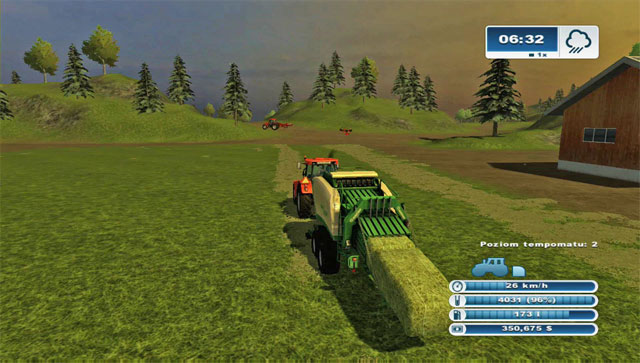
Afterwards buy the Krone Big Pack 1290 baler for 120 000 $ and take it to the field. The previously mowed grass is now hay which can be turned into square haystacks (speed 2, you cannot hire a worker).

You need a lifter using which you will be able to transport the squared hay. For 103 000 $ you can buy the Deutz Agrovector 35.7 with a bale fork for 1 000 $ (if you decide to maximally develop your husbandry and didn't yet buy a loader, you should go ahead and purchase the Weidemann 4270 CX100 T). Move all bales to the cow manger.
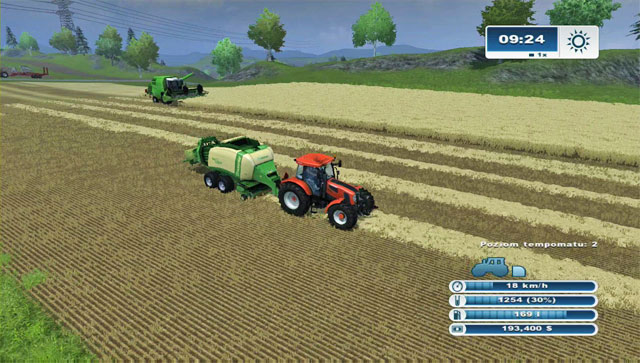
The second thing you need is straw (which is a by-product of harvesting grains, e.g. wheat or barley). The combine will arrange the straw is windrows, so it's easier to gather it. You do it with the same implement used for collecting hay. One of the ways of obtaining straw is heading to a freshly harvested field. Before using the cultivator, drive the baler across it and you will create straw bales.
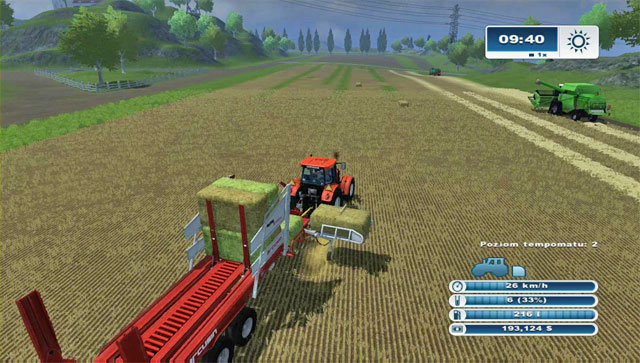
Unfortunately there's the problem of transporting those bales to the cow pasture. The most convenient way is using the Arcusin Autostack FS 63-72 trailer, however it will cost you a whooping 95 980 $. It's a good choice if you really need a lot of hay and straw bales. At this stage you can buy a small field by the cow pasture (e.g. number 30 or use 29 for that purpose) and bring the sower and tractor there. Plant seeds, harvest the grains and bale the leftover hay. Afterwards you can transport it to the farm by less expensive means like the Deutz Agrovector 35.7. You can also buy a common trailer for 3 600 $ put the bales onto it and transport it to the cow pasture.
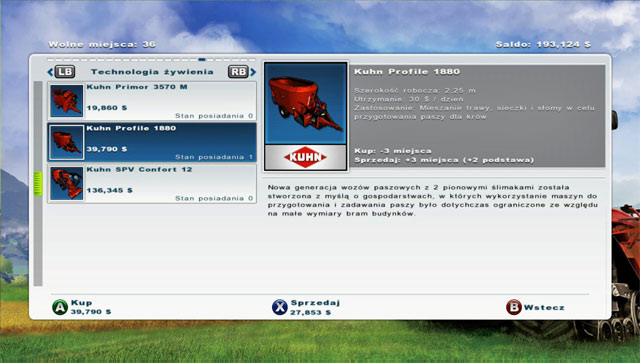
It's time to spend 39 700 $ on the Kuhn Profile 18880 mixer wagon, in fact the most important machine. Bring it to the cow pasture, to the area of the manger.
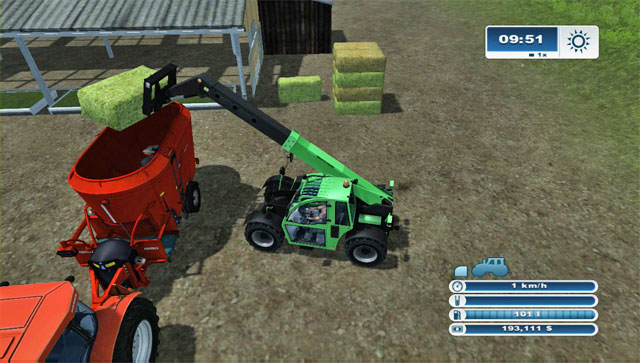
You need to throw the proper amount of hay, straw and silage so that you forage is perfect. The recipe is: one hay bale, followed by one straw bale (hay bales are green and straw bales are yellow). Afterwards add 2-4 forks of silage (check the status of the mixer after each silage load).
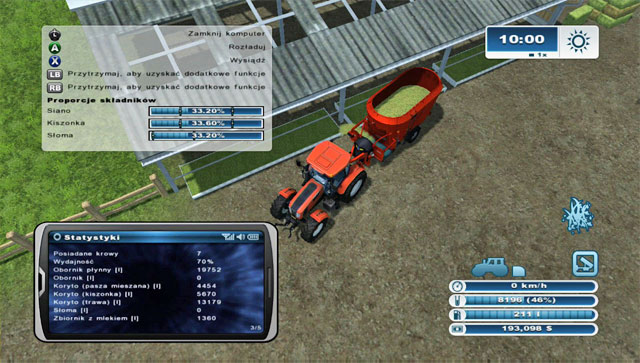
Your aim is to keep the hay and silage at 20% - 50% and the straw around 40%. When you hit the mark, unload the mix into the manger. That way the effectiveness will soar to 90% (if your cows didn't have anything to eat, it will change from 0% to 90%!)
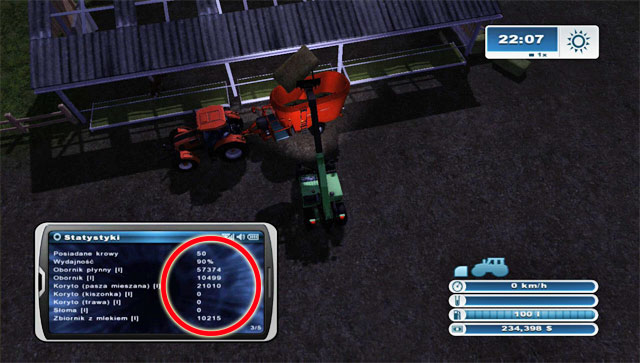
In order to obtain the last 10% and reach 100%, you should throw 1-2 hay bales into the mixer and unload it into the manger. Congratulations! That way the effectiveness has reached 100%. At the same time, because of the straw addition, manure will become available.
NOTICE! 50 cows needs around 12 500 l of forage and around 4 000 l of straw daily. At the same time the cows will produce 26 000 $ worth of milk every day and nearly 10 000 l of manure. Now you just have to make sure that the cows are supplied with forage and straw. Don't refill grass or silage - they won't eat it as long as there's forage available.
Investment: around 421 230 $ (100 000 $ for fifty cows, 22 000 $ for the field, 8 840 $ for the mower, 15 990 $ for the tedder, 8 200 $ for the windrower, 120 000 $ for the baler, 106 500 $ for the Deutz Agrovector 35.7 loader with two heads, 39 700 $ for the mixer; the sower and combine weren't included; if you add the bale-collecting trailer and a wider windrower, the total sum will almost hit 550 000 $);
Return on investment: around 16-20 days (the daily profit from selling milk from 50 cows is around 26 000 $; when fed with forage and straw, the effectiveness is 100%);
Conclusion: husbandry at such a scale is very profitable, what's more, you should still consider expanding it by buying more cows; truth is it's rather absorbing, as you have to create new forage every couple days and remember to bale straw during harvest, but the enormous profits are worth it; remember that the more cows you buy, the higher the profitability and the lower the return on investment.
You are not permitted to copy any image, text or info from this page. This site is not associated with and/or endorsed by the developers and the publishers. All logos and images are copyrighted by their respective owners.
Copyright © 2000 - 2025 Webedia Polska SA for gamepressure.com, unofficial game guides, walkthroughs, secrets, game tips, maps & strategies for top games.
